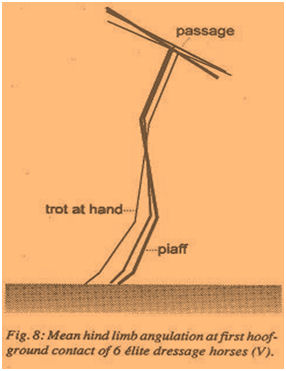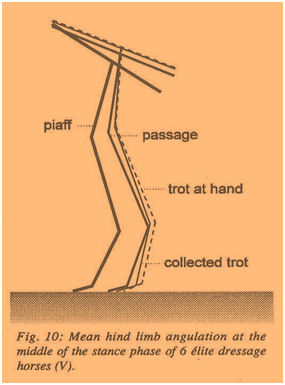Gestures verses Energy
Gestures verses Energy
Equine Biomechanics
(small piece of a transcript from a video for the IHTC 5)
Jean Luc Cornille
Gestures verses Energy
“The man who views the world at 50 the same as he did at 20 has wasted 30 years of his life.” (Muhammad Ali)
Many equestrians are wasting decades of their life perpetuating postural equitation, neck position, limbs placements, rider position, correct aids, etc., instead of evolving with actual understanding of the dynamics involved.
About two decades ago, a German trainer promised the mastery of the piaff activating the horse’s hind legs with a dressage whip and the horse’s forelegs with a bamboo pole. This was a perfect oxymoron; touching the forelegs with a bamboo pole, the trainer attempted correcting the front limbs’ kinematics abnormalities that he created activating the hind legs with a dressage whip. When the dynamics of equine athletic performances is not understood, and therefore, trainers are unable to develop and coordinate efficiently the horse’s physique for the athletic demand of the performance, they simulate limbs gestures mimicking the performances. Instead of furthering their equitation and education in the light of new knowledge, they return to archaism wasting decades of their students’ life and the horses’ entire life.
The twenty first Century started with a new line of thinking. Under the title, “Horses damper their spring in their stride,” Allan Wilson and Antony von den Booger wrote, ““The muscular work of galloping in horses is halved by storing and returning elastic strain energy in spring-like muscle-tendon units.” (Alan M. Wilson, M. Polly McGulgan, Anne Su & Anton J. van den Bogertt, Department of Biomedical Engineering, Cleveland Clinic Foundation - 2001) Originally, elastic properties were believed to be exclusively at the level of the distal limbs’ long tendons; deep digital, superficial flexor tendons and suspensory ligaments, store energy when they elongate, which they release when they return to their normal length. Further studies have demonstrated a much advanced usage of elastic strain energy through the whole muscular system. Muscles are composed of cells and connective tissues often referred to as “tendinous material” and elastic strain energy occurs within the muscle in the absence of tendon. A great part of the limbs protraction, elevation and amplitude are the outcome of elastic strain energy produced during the stance or support phase. This of course is related to adequate coordination of the horse’s whole physique. Trainers who are unable to achieve appropriated coordination of the horse’s physique try faking hind and front legs movements touching or hitting the limbs with a bamboo perch or a dressage whip.
The pantomime is not harmless. From neck oscillations to thoracolumbar movements, limbs and vertebral column have to work in harmony. When instead of maximizing the elastic recoil of the forelegs, trainers try creating elevation touching the front limbs with a bamboo pole, they alter elastic recoil forcing the horse less efficient locomotion and more intense muscular work. Gaits and performances are like an artistic event. They are sublime orchestration of kinematics energy, creating kinetic energy, enhancing kinematics energy. When a whip or a bamboo pole comes in the story is like a perch placed in the middle of a complex gearing. It disrupts the whole mechanism. One just has to look at the swing phase of the hind legs of a horse working over cavalettis. A great part of the hind legs’ forward swing results from the elastic stain energy accumulated during the stance. The limb swing forward and the hoof flies low above the ground. If a pole is on the ground, and therefore, on the trajectory of the forward swing of the hoof, the swing is compromised and the horse contracts the gastrocnemian muscles which lift the hock up and back. The kinematics of the hind limbs is then totally different. Instead of swinging energetically forward, the hind limb executes an upward movement at the level of the hocks that flattens the pelvis.
Horses deal with training incongruities altering the kinematics of their hind and front limbs. Flattening of the pelvis alters normal forward swing of the protracting hind limb. The horse compensates increasing the rotation of the femur around the hip joint. James Rooney explained in 1976 how increasing the rotation of the femur around the hip joint compromised stability and integrity of the stifle. This happens over cavalettis but also on the flat when hind legs engagement is stimulated without adequate dorso-ventral rotation of the pelvic and therefore proper mechanism of the thoracolumbar column. When asked for deeper engagement of the hind legs without proportional flexion of the thoracolumbar spine, the horse increases the rotation of the femur around the hip joint. While rotating around the hip joint, the femur undergoes simultaneously an inward rotation around the tibia. This rotary movement of the femur occurs toward the outside, (medial-to-lateral,) during the swing phase and toward the inside, (lateral-to-medial,) during the support phase. As the protracting hind leg swings forward, the stifle extends and the usual medial-to-lateral rotation occurs. “If the extension is carried on beyond about 143-145°, there is a final lateral-to-medial twist, which rotates the patella medially and hooks the medial patellar ligament over the medial ridge of the femoral trochlea. The stifle is “locked” and flexion prevented.” (James R, Rooney, Biomechanics of lameness in horses, 1968) This is the mechanism of accidental locking of the patella. Quickly, the horse’s brain prevents accidental lock lifting the patella contracting the quadriceps muscle and moving the patella laterally contracting the biceps. However, cartilage and ligaments of the stifle joint are stressed abnormally and the repetition of such abnormal stresses causes injury. This is why we never use cavalettis for the reeducation of stifle problem. In fact, this is why we never use cavalettis at all.
Activating the hind and front limbs instead of educating the horse’s thoracolumbar column is primitive equitation. It is the reason for so many mediocre piaff performances. The German trainer who activated the horse’s hind legs with dressage whip remained in the thought process that he had when he was 20. The belief was at this time that a horse executes the piaff increasing the propulsive activity of the hind legs. Decades later, with the advance or research studies and technology, it was observed that, at the contrary, a horse responds to the athletic challenge of the piaff increasing the decelerating activity of the supporting hind leg. This sequence of the stride is also referred to as “braking” activity. As hips, stifle, hock and fetlock joints fold, the supporting hind limb resists attraction of gravity and inertia forces. The main work of the supporting hind legs is resisting forward displacement of the body over the forelegs. “The hind legs have a considerable braking activity to avoid forward movement of the body over the forelegs.(…) The forelimbs have a larger propulsive activity.” (Eric Barrey, Sophie Biau, Locomotion of dressage horses Conference on Equine Sports Medicine and Science - 2002)
The propulsive activity of the hind leg is reduced to the minimum and this phenomenon is easy to understand.  In his quantitative studies on gaits and performances of Swedish Warmblood, Mikael Holmström observed that during piaff, a horse engages the supporting hind leg less forward than during collected trot. Holmström’s diagram shows the position of the hind leg at impact during trot in hand, which is where the hind leg engages the most, passage, which is the middle line and Piaff, where the hind leg is the less engaged.
In his quantitative studies on gaits and performances of Swedish Warmblood, Mikael Holmström observed that during piaff, a horse engages the supporting hind leg less forward than during collected trot. Holmström’s diagram shows the position of the hind leg at impact during trot in hand, which is where the hind leg engages the most, passage, which is the middle line and Piaff, where the hind leg is the less engaged.
This of course contradicts the belief of the ones who still see the piaff at 50, the way they saw it at 20. Holmström shows another diagram illustrating a different sequence of the stride. On the first diagram, the supporting hind limb is in the decelerating phase. This is the sequence that the horse increases considerably during the piaff. At the trot as well as passage, the horse’s body moves forward. Instead, there is little forward displacement of the body at the piaff. It is therefore not surprising that in relation to other gaits such as trot or passage, the position of the hind limb is more forward at the instant of the pushing phase.
At the walk, the hind legs are acting as levers. The scientific description is “inverted pendulum.”  The propulsive activity is therefore more horizontal. At the trot, the hind limbs are acting as spring, producing a more vertical force. As the horse’s body does not move much forward during piaff, the spring propulsive activity of the supporting hind leg lifts the croup shifting the weight over the forelegs.
The propulsive activity is therefore more horizontal. At the trot, the hind limbs are acting as spring, producing a more vertical force. As the horse’s body does not move much forward during piaff, the spring propulsive activity of the supporting hind leg lifts the croup shifting the weight over the forelegs.
Horses submitted to this type of misconception deal with the problem created by the training error shifting the front limbs backward underneath their body. They look like a mountain goat on a mountain peak, balancing themselves over the forelegs. Interestingly, the expression, ‘mountain goat on a mountain peak,’ was created by Gustave Steinbrecht criticizing the work of François Baucher. Obviously, bamboo trainers do not read their classics.
There is a considerable decelerating activity of the hind legs during piaff and very little propulsive activity. Considering that during piaff, the hoof of the supporting hind leg is under the croup, it is easy to understand that the propulsive activity of the hind leg, which is done extending the joints, does lift the croup. If the pelvis is raised, horizontal forces are diminished but gravitational forces are doubly increased since raising the pelvis increases weight exerted at the anterior end and the pushing force is added to the gravitational forces at the anterior end.” (Richard Tucker, Contribution to the Biomechanics of the vertebral Column, Acta Thoeriologica, VOL. IX, 13: 171-192, BIALOWIEZA, 30. XL. 1964)
Shifting the forelegs backward hampers proper dynamics and consequently kinematics of the forelegs. The front limbs carry too much weight and are no longer capable of propelling the horse’s body upward. During piaff, the forelegs produce a considerable upward propulsive activity. The consequence of this propulsive activity is an elevation of the legs and knees during the swing phase. Of course, when the forelegs carry too much weight and are shifted backward, they can’t develop adequate vertical impulse and the first consequence is that they lose the rhythm of the forelegs movements. Instead of a diagonal and rhythmic motion, the piaff became a marching band type of walk. Without propulsive activity, there is no elevation of the limb during the swing phase and this is where trainers who do not have any understanding of how the horse does it, camouflage their ignorance touching the front limbs with a bamboo pole.
Forward swing of the forelegs is the elastic consequence of proper propulsion, which is itself the consequence of proper functioning of the horse’s vertebral column mechanism. This true for the piaff and this is true for every gaits and performances. When incompetence does not coordinate the horse’s physique efficiently, hind and front limbs actions are poor. When trainers resort to gestures such as touching the limbs with whatever equipment they like using, they create a dysfunctional horse and downgrade the equestrian art into pantomime. In most instances, the outcome is lameness.
Jean Luc Cornille
scienceofmotion.com
2013



 twitter
twitter facebook
facebook digg
digg google
google stumbleupon
stumbleupon pinterest
pinterest linkedin
linkedin